ITC508 - Case Study: Object and Data Modeling of Collin's Car Park
VerifiedAdded on 2023/06/13
|15
|2957
|494
Case Study
AI Summary
This document presents a comprehensive object and data modeling case study of Collin's Car Parking System. It begins by outlining the functional and non-functional requirements, including message displaying, authentication, authorization, payment handling, report generation, data storage, availability, recoverability, security, scalability, and usability. The study then provides a use case model, detailing various user interactions such as reservation, car parking, account supervision, registration, parking space management, and billing. A fully developed use case description for the 'Parking' use case is included, illustrating the flow of events and potential extensions. Furthermore, the document features a UML domain model class diagram representing the system's structure and relationships. Finally, it discusses the five stages of the Software Development Life Cycle (SDLC) - planning, designing, building, testing, and implementation - outlining specific tasks required for each stage in the context of the car parking system.
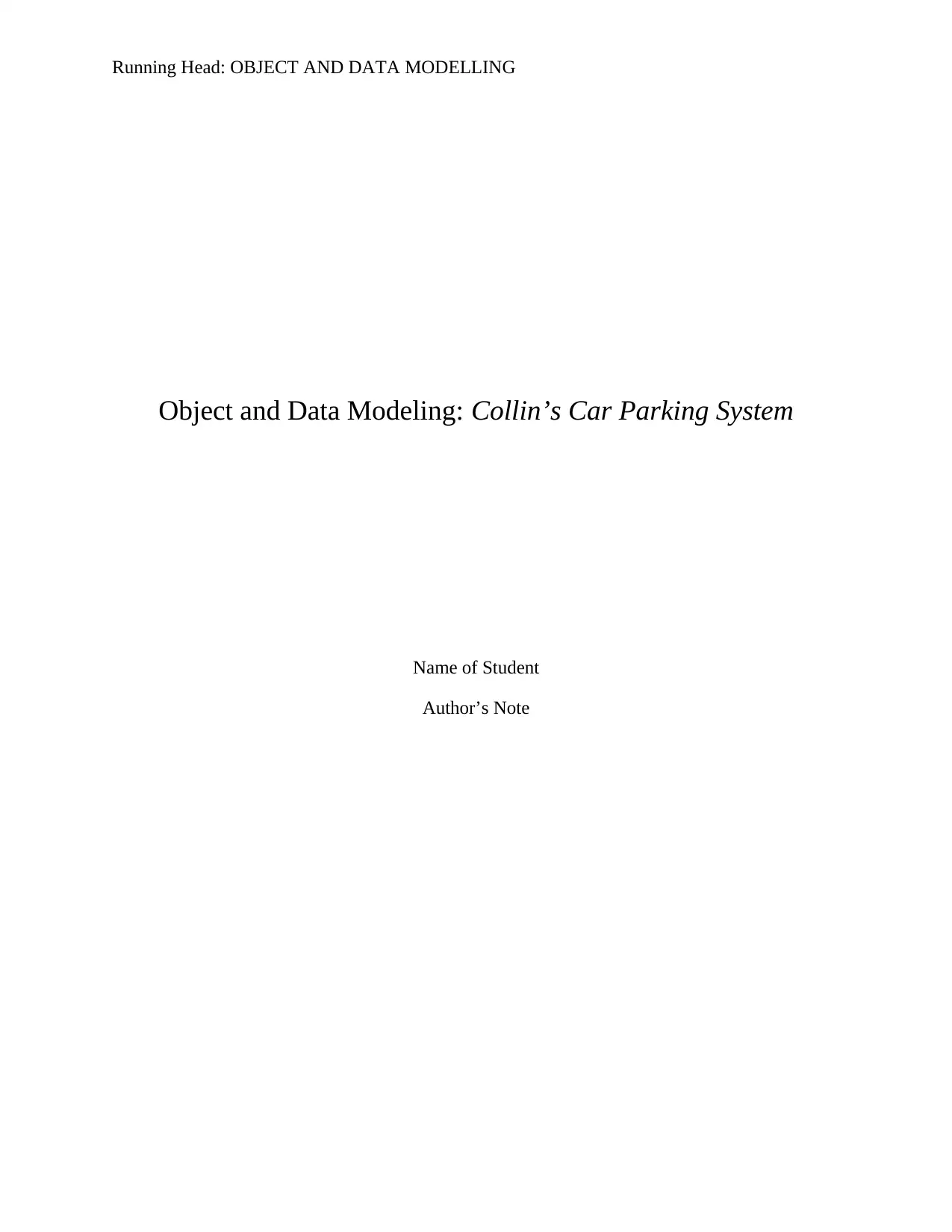
Running Head: OBJECT AND DATA MODELLING
Object and Data Modeling: Collin’s Car Parking System
Name of Student
Author’s Note
Object and Data Modeling: Collin’s Car Parking System
Name of Student
Author’s Note
Paraphrase This Document
Need a fresh take? Get an instant paraphrase of this document with our AI Paraphraser
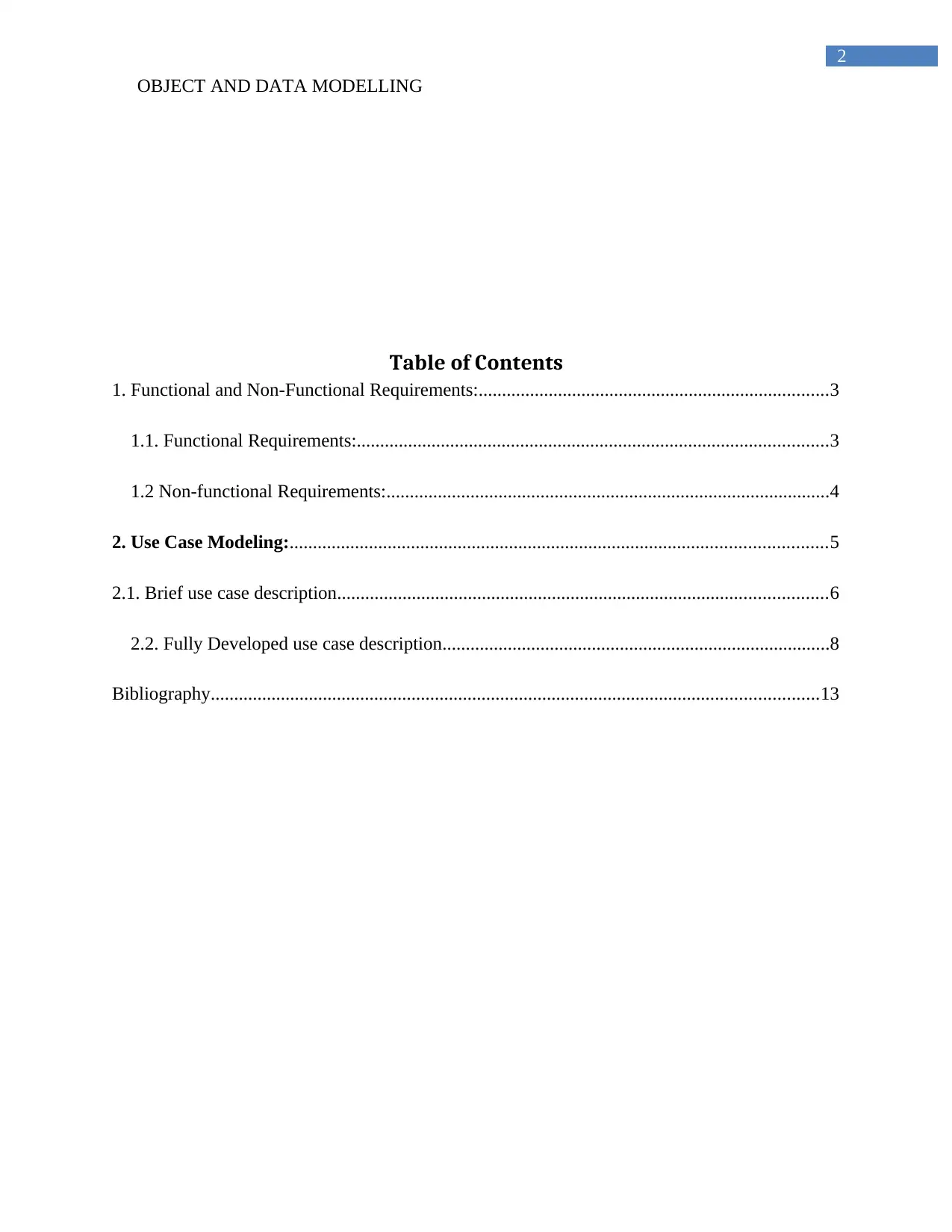
2
OBJECT AND DATA MODELLING
Table of Contents
1. Functional and Non-Functional Requirements:...........................................................................3
1.1. Functional Requirements:.....................................................................................................3
1.2 Non-functional Requirements:...............................................................................................4
2. Use Case Modeling:...................................................................................................................5
2.1. Brief use case description.........................................................................................................6
2.2. Fully Developed use case description...................................................................................8
Bibliography..................................................................................................................................13
OBJECT AND DATA MODELLING
Table of Contents
1. Functional and Non-Functional Requirements:...........................................................................3
1.1. Functional Requirements:.....................................................................................................3
1.2 Non-functional Requirements:...............................................................................................4
2. Use Case Modeling:...................................................................................................................5
2.1. Brief use case description.........................................................................................................6
2.2. Fully Developed use case description...................................................................................8
Bibliography..................................................................................................................................13

3
OBJECT AND DATA MODELLING
1. Functional and Non-Functional Requirements:
1.1. Functional Requirements:
a. Message Displaying: This particular system will display different messages as well as
responses to customers throughout the display that is installed in pillars. Once user appears at
pillar, the sensor installed in particular system senses the presence of vehicles and display the
required messages as well as options.
b. Authentication: This is the process to verify a user by doing real time checking of ticket and
retrieving all types of details from their saved databases. Once the ticket validation is done,
customer will get authenticated to enter the parking lot.
c. Authorization: This the process to authorize the validation of the user request for the parking
area. The whole process is consists of different levels that also different for both fixed customers
and normal customers. The whole authorization process gets done from the core of any system.
The identification of customers will be done by doing the proper uses of issues ticket.
d. Handing of Payment: This particular system will also check the payment done. For some fixed
customers, the system takes all charges for ticket at a time of generation. The card will be
entered to ticket reader device and the exact payment gets deducted by calculating the parked
time. The payment of parking card can also be done by using debit/credit card or cash.
e. Report Generation: The system will generate reports retrieving their stored data and
information. This report can only be accessed by the management supervisors only. It also
generates report in all weekly basis, monthly as well as on yearly basis also. The report get
stored in the system for life time so that it can be checked any time.
OBJECT AND DATA MODELLING
1. Functional and Non-Functional Requirements:
1.1. Functional Requirements:
a. Message Displaying: This particular system will display different messages as well as
responses to customers throughout the display that is installed in pillars. Once user appears at
pillar, the sensor installed in particular system senses the presence of vehicles and display the
required messages as well as options.
b. Authentication: This is the process to verify a user by doing real time checking of ticket and
retrieving all types of details from their saved databases. Once the ticket validation is done,
customer will get authenticated to enter the parking lot.
c. Authorization: This the process to authorize the validation of the user request for the parking
area. The whole process is consists of different levels that also different for both fixed customers
and normal customers. The whole authorization process gets done from the core of any system.
The identification of customers will be done by doing the proper uses of issues ticket.
d. Handing of Payment: This particular system will also check the payment done. For some fixed
customers, the system takes all charges for ticket at a time of generation. The card will be
entered to ticket reader device and the exact payment gets deducted by calculating the parked
time. The payment of parking card can also be done by using debit/credit card or cash.
e. Report Generation: The system will generate reports retrieving their stored data and
information. This report can only be accessed by the management supervisors only. It also
generates report in all weekly basis, monthly as well as on yearly basis also. The report get
stored in the system for life time so that it can be checked any time.
⊘ This is a preview!⊘
Do you want full access?
Subscribe today to unlock all pages.

Trusted by 1+ million students worldwide
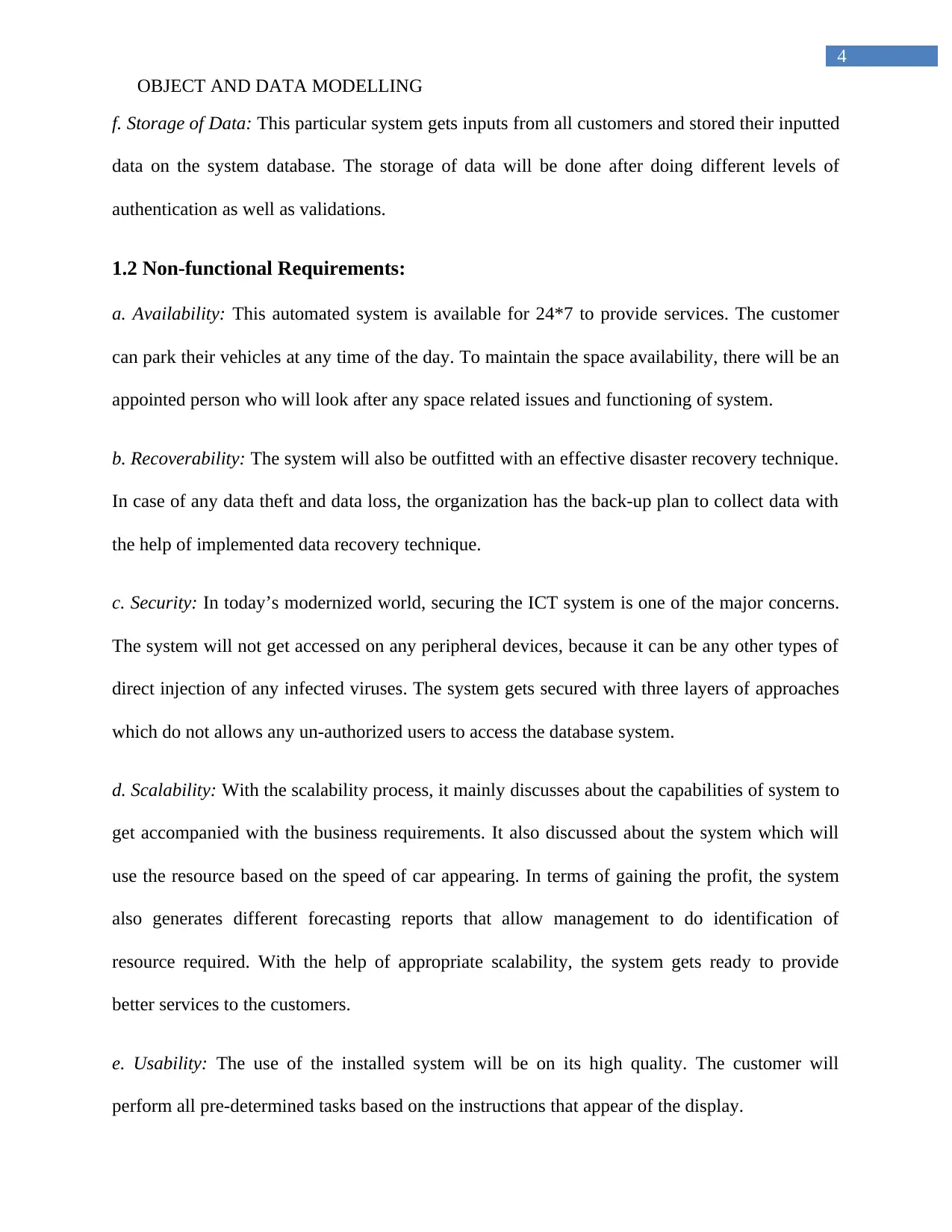
4
OBJECT AND DATA MODELLING
f. Storage of Data: This particular system gets inputs from all customers and stored their inputted
data on the system database. The storage of data will be done after doing different levels of
authentication as well as validations.
1.2 Non-functional Requirements:
a. Availability: This automated system is available for 24*7 to provide services. The customer
can park their vehicles at any time of the day. To maintain the space availability, there will be an
appointed person who will look after any space related issues and functioning of system.
b. Recoverability: The system will also be outfitted with an effective disaster recovery technique.
In case of any data theft and data loss, the organization has the back-up plan to collect data with
the help of implemented data recovery technique.
c. Security: In today’s modernized world, securing the ICT system is one of the major concerns.
The system will not get accessed on any peripheral devices, because it can be any other types of
direct injection of any infected viruses. The system gets secured with three layers of approaches
which do not allows any un-authorized users to access the database system.
d. Scalability: With the scalability process, it mainly discusses about the capabilities of system to
get accompanied with the business requirements. It also discussed about the system which will
use the resource based on the speed of car appearing. In terms of gaining the profit, the system
also generates different forecasting reports that allow management to do identification of
resource required. With the help of appropriate scalability, the system gets ready to provide
better services to the customers.
e. Usability: The use of the installed system will be on its high quality. The customer will
perform all pre-determined tasks based on the instructions that appear of the display.
OBJECT AND DATA MODELLING
f. Storage of Data: This particular system gets inputs from all customers and stored their inputted
data on the system database. The storage of data will be done after doing different levels of
authentication as well as validations.
1.2 Non-functional Requirements:
a. Availability: This automated system is available for 24*7 to provide services. The customer
can park their vehicles at any time of the day. To maintain the space availability, there will be an
appointed person who will look after any space related issues and functioning of system.
b. Recoverability: The system will also be outfitted with an effective disaster recovery technique.
In case of any data theft and data loss, the organization has the back-up plan to collect data with
the help of implemented data recovery technique.
c. Security: In today’s modernized world, securing the ICT system is one of the major concerns.
The system will not get accessed on any peripheral devices, because it can be any other types of
direct injection of any infected viruses. The system gets secured with three layers of approaches
which do not allows any un-authorized users to access the database system.
d. Scalability: With the scalability process, it mainly discusses about the capabilities of system to
get accompanied with the business requirements. It also discussed about the system which will
use the resource based on the speed of car appearing. In terms of gaining the profit, the system
also generates different forecasting reports that allow management to do identification of
resource required. With the help of appropriate scalability, the system gets ready to provide
better services to the customers.
e. Usability: The use of the installed system will be on its high quality. The customer will
perform all pre-determined tasks based on the instructions that appear of the display.
Paraphrase This Document
Need a fresh take? Get an instant paraphrase of this document with our AI Paraphraser
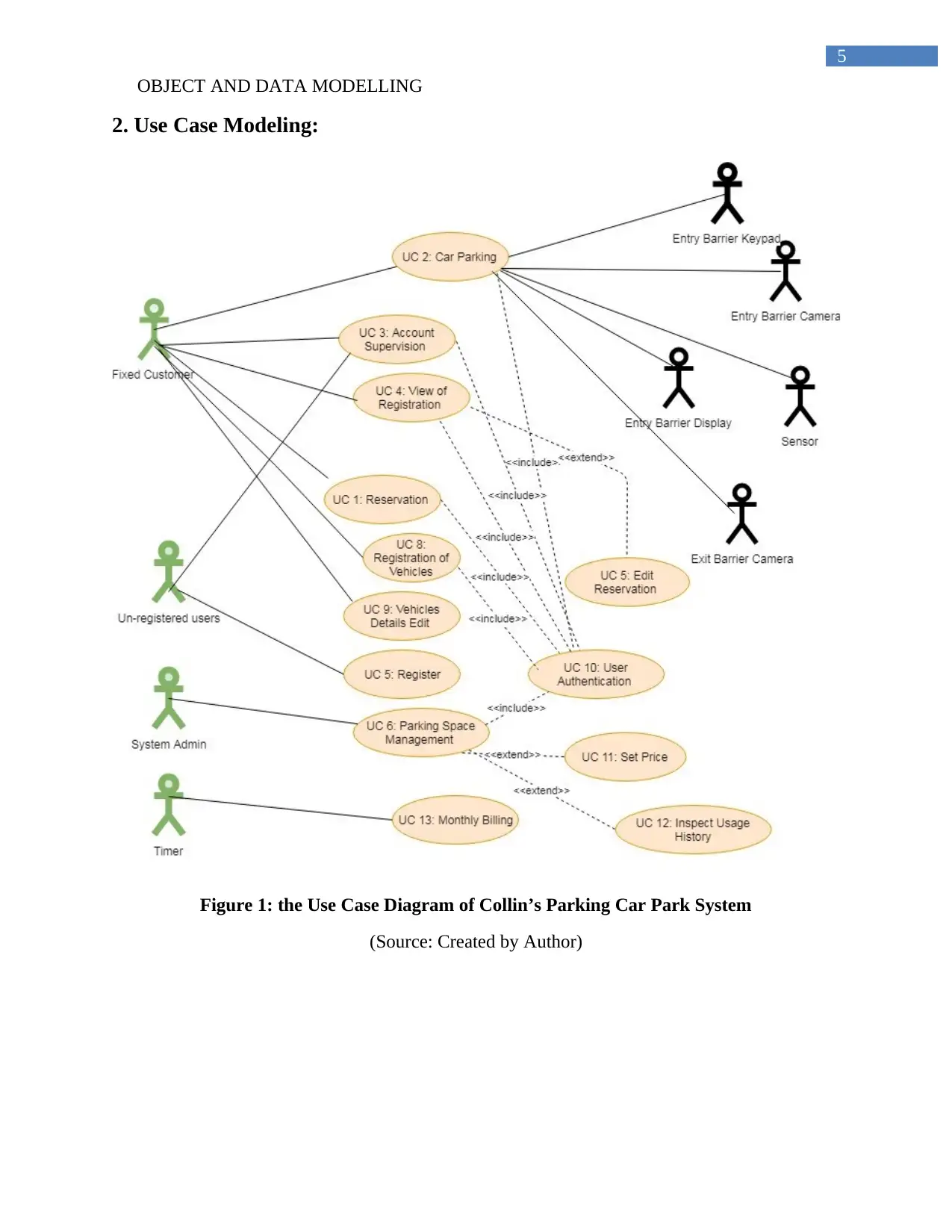
5
OBJECT AND DATA MODELLING
2. Use Case Modeling:
Figure 1: the Use Case Diagram of Collin’s Parking Car Park System
(Source: Created by Author)
OBJECT AND DATA MODELLING
2. Use Case Modeling:
Figure 1: the Use Case Diagram of Collin’s Parking Car Park System
(Source: Created by Author)
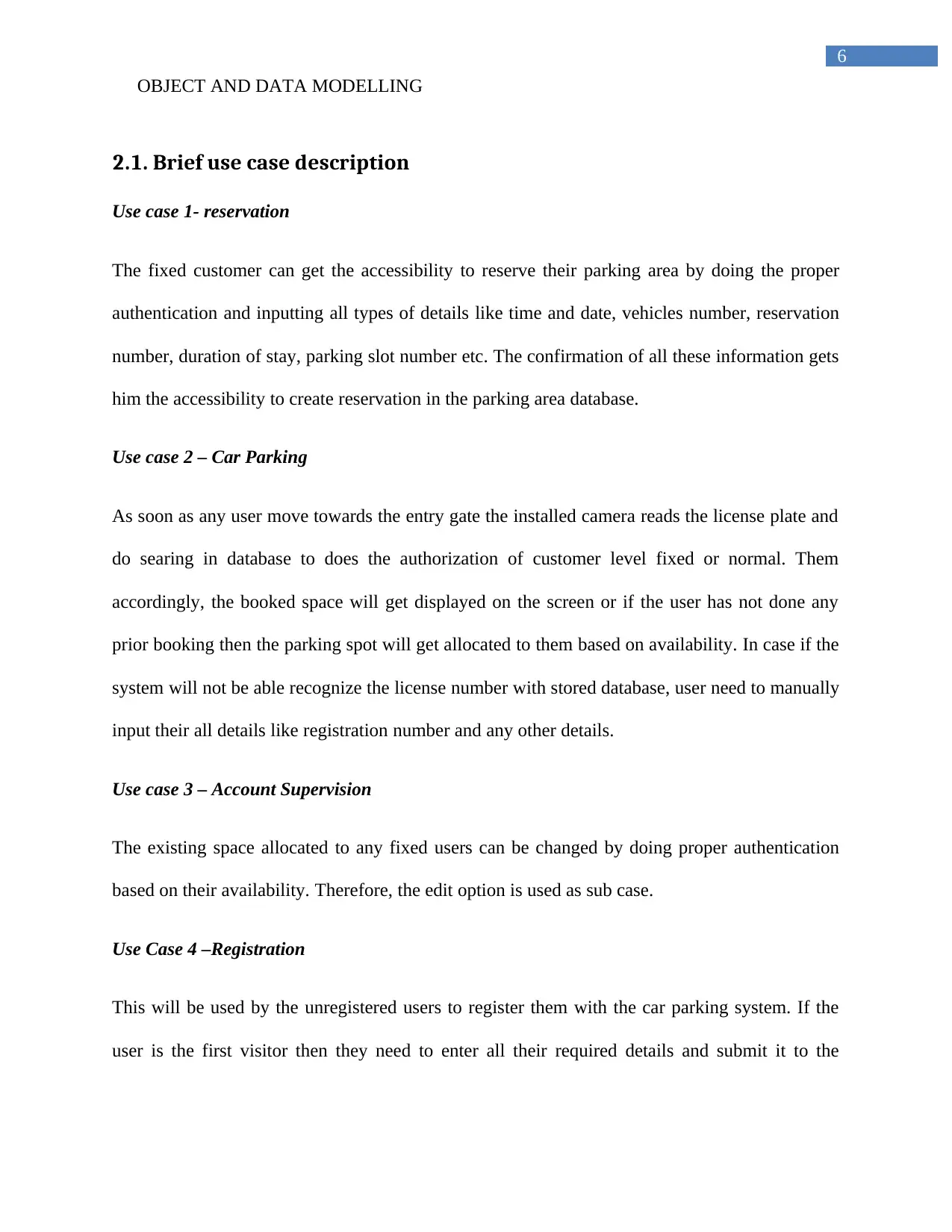
6
OBJECT AND DATA MODELLING
2.1. Brief use case description
Use case 1- reservation
The fixed customer can get the accessibility to reserve their parking area by doing the proper
authentication and inputting all types of details like time and date, vehicles number, reservation
number, duration of stay, parking slot number etc. The confirmation of all these information gets
him the accessibility to create reservation in the parking area database.
Use case 2 – Car Parking
As soon as any user move towards the entry gate the installed camera reads the license plate and
do searing in database to does the authorization of customer level fixed or normal. Them
accordingly, the booked space will get displayed on the screen or if the user has not done any
prior booking then the parking spot will get allocated to them based on availability. In case if the
system will not be able recognize the license number with stored database, user need to manually
input their all details like registration number and any other details.
Use case 3 – Account Supervision
The existing space allocated to any fixed users can be changed by doing proper authentication
based on their availability. Therefore, the edit option is used as sub case.
Use Case 4 –Registration
This will be used by the unregistered users to register them with the car parking system. If the
user is the first visitor then they need to enter all their required details and submit it to the
OBJECT AND DATA MODELLING
2.1. Brief use case description
Use case 1- reservation
The fixed customer can get the accessibility to reserve their parking area by doing the proper
authentication and inputting all types of details like time and date, vehicles number, reservation
number, duration of stay, parking slot number etc. The confirmation of all these information gets
him the accessibility to create reservation in the parking area database.
Use case 2 – Car Parking
As soon as any user move towards the entry gate the installed camera reads the license plate and
do searing in database to does the authorization of customer level fixed or normal. Them
accordingly, the booked space will get displayed on the screen or if the user has not done any
prior booking then the parking spot will get allocated to them based on availability. In case if the
system will not be able recognize the license number with stored database, user need to manually
input their all details like registration number and any other details.
Use case 3 – Account Supervision
The existing space allocated to any fixed users can be changed by doing proper authentication
based on their availability. Therefore, the edit option is used as sub case.
Use Case 4 –Registration
This will be used by the unregistered users to register them with the car parking system. If the
user is the first visitor then they need to enter all their required details and submit it to the
⊘ This is a preview!⊘
Do you want full access?
Subscribe today to unlock all pages.

Trusted by 1+ million students worldwide
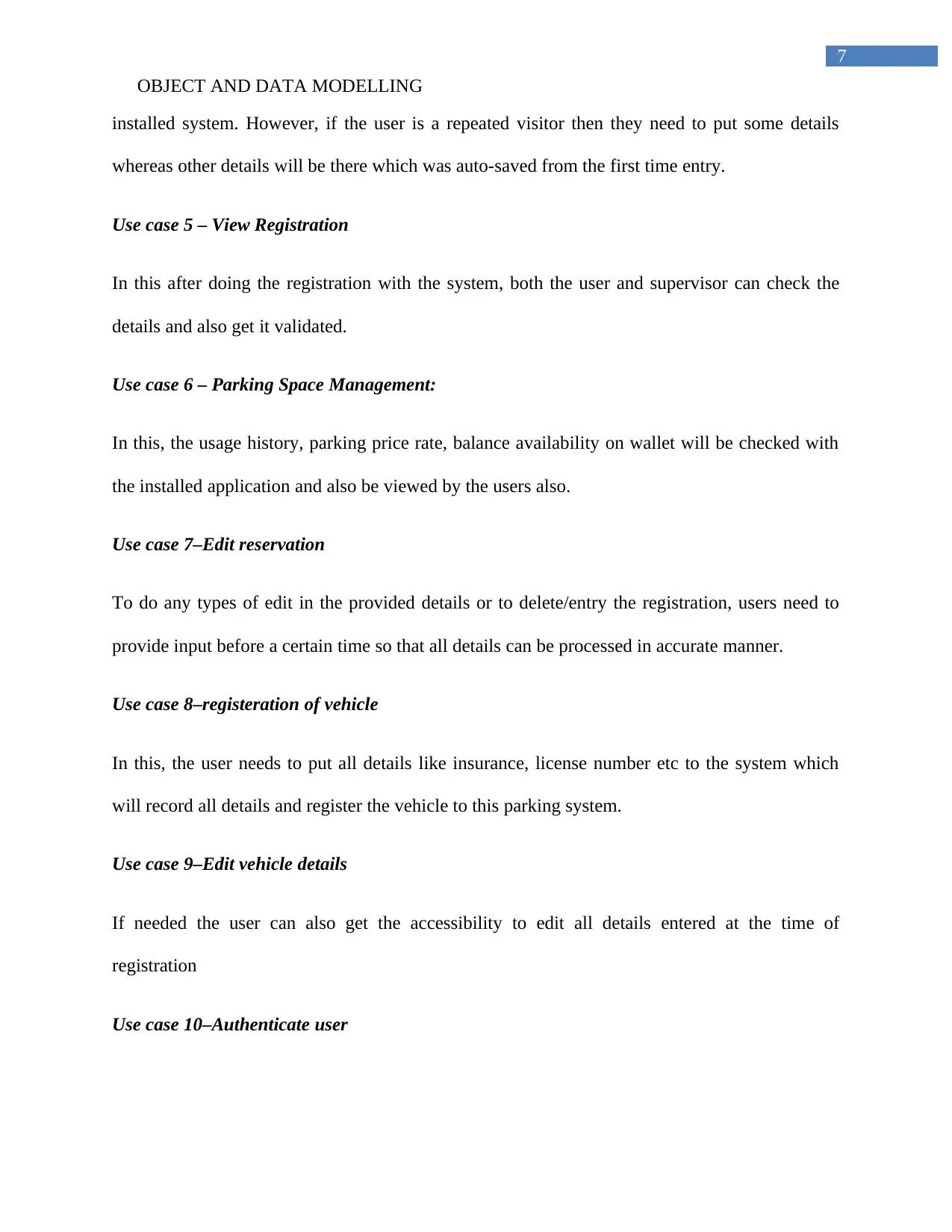
7
OBJECT AND DATA MODELLING
installed system. However, if the user is a repeated visitor then they need to put some details
whereas other details will be there which was auto-saved from the first time entry.
Use case 5 – View Registration
In this after doing the registration with the system, both the user and supervisor can check the
details and also get it validated.
Use case 6 – Parking Space Management:
In this, the usage history, parking price rate, balance availability on wallet will be checked with
the installed application and also be viewed by the users also.
Use case 7–Edit reservation
To do any types of edit in the provided details or to delete/entry the registration, users need to
provide input before a certain time so that all details can be processed in accurate manner.
Use case 8–registeration of vehicle
In this, the user needs to put all details like insurance, license number etc to the system which
will record all details and register the vehicle to this parking system.
Use case 9–Edit vehicle details
If needed the user can also get the accessibility to edit all details entered at the time of
registration
Use case 10–Authenticate user
OBJECT AND DATA MODELLING
installed system. However, if the user is a repeated visitor then they need to put some details
whereas other details will be there which was auto-saved from the first time entry.
Use case 5 – View Registration
In this after doing the registration with the system, both the user and supervisor can check the
details and also get it validated.
Use case 6 – Parking Space Management:
In this, the usage history, parking price rate, balance availability on wallet will be checked with
the installed application and also be viewed by the users also.
Use case 7–Edit reservation
To do any types of edit in the provided details or to delete/entry the registration, users need to
provide input before a certain time so that all details can be processed in accurate manner.
Use case 8–registeration of vehicle
In this, the user needs to put all details like insurance, license number etc to the system which
will record all details and register the vehicle to this parking system.
Use case 9–Edit vehicle details
If needed the user can also get the accessibility to edit all details entered at the time of
registration
Use case 10–Authenticate user
Paraphrase This Document
Need a fresh take? Get an instant paraphrase of this document with our AI Paraphraser

8
OBJECT AND DATA MODELLING
The account for any fixed user is only created in the system, the user just need to login to the
system. All details are get automatically fetched from the stored database which users can
automatically access the stored details.
Use case 11–Set price
Different tariff plans will be shown to the users and the user can choose their plan based on their
needs.
Use case 12–inspect usage history
This can only be accessed by the system supervisors to view all details of users and also can
checked the usage history of all types of users both fixed and ordinary.
Use case 13–Monthly billing
If in case the user opt for post-paid option, the machine generated bill get operated on monthly
basis and sent to their registered emails and phone numbers so that it can be paid on time.
2.2. Fully Developed use case description
Use case 2 Parking
Actor Fixed users, normal users
Goals of the actor To park the vehicle
Participating actor Display, Entry Camera, keypad, spot sensor, exit
camera and database.
Precondition The entry point is empty
Post Condition A parking space is allocated and the database is
updated.
OBJECT AND DATA MODELLING
The account for any fixed user is only created in the system, the user just need to login to the
system. All details are get automatically fetched from the stored database which users can
automatically access the stored details.
Use case 11–Set price
Different tariff plans will be shown to the users and the user can choose their plan based on their
needs.
Use case 12–inspect usage history
This can only be accessed by the system supervisors to view all details of users and also can
checked the usage history of all types of users both fixed and ordinary.
Use case 13–Monthly billing
If in case the user opt for post-paid option, the machine generated bill get operated on monthly
basis and sent to their registered emails and phone numbers so that it can be paid on time.
2.2. Fully Developed use case description
Use case 2 Parking
Actor Fixed users, normal users
Goals of the actor To park the vehicle
Participating actor Display, Entry Camera, keypad, spot sensor, exit
camera and database.
Precondition The entry point is empty
Post Condition A parking space is allocated and the database is
updated.
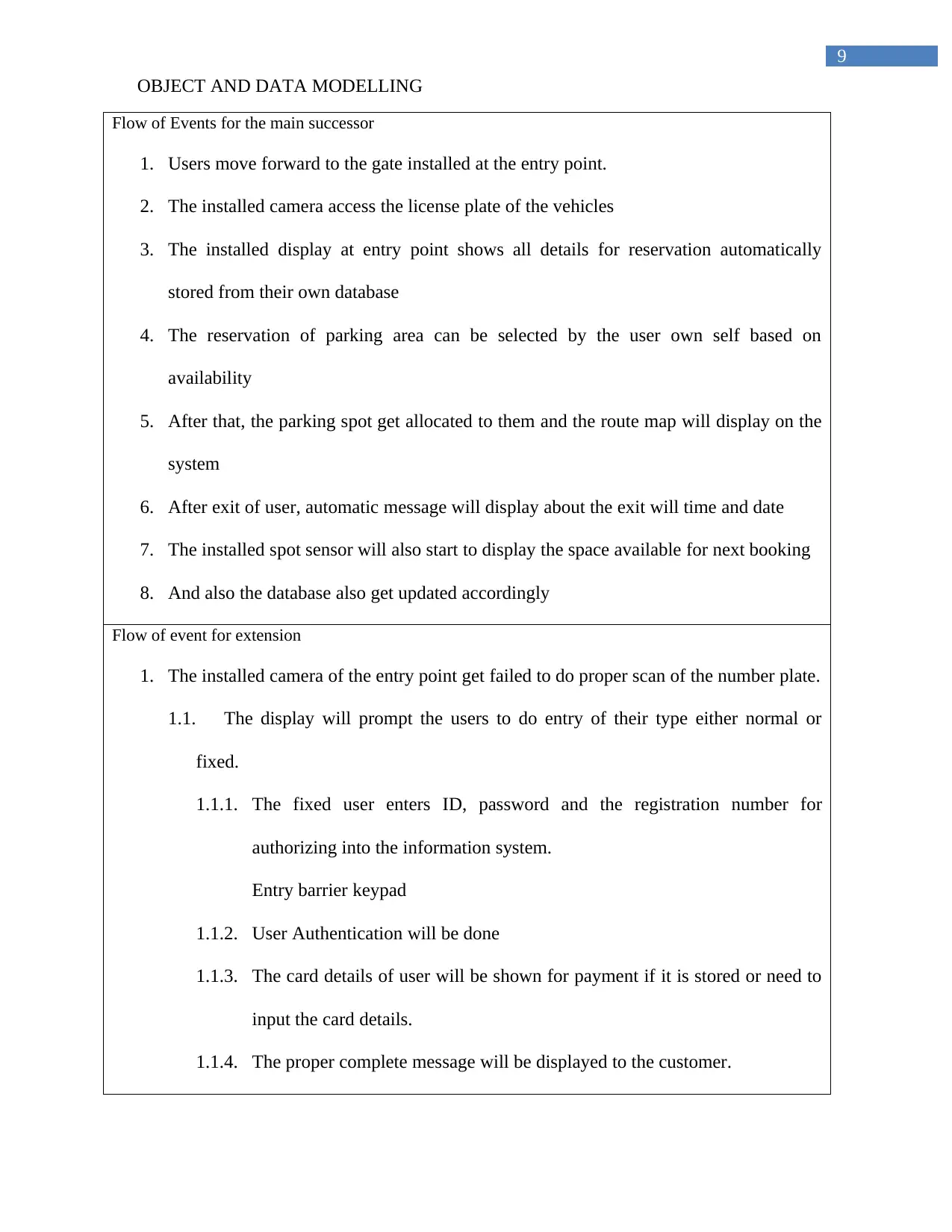
9
OBJECT AND DATA MODELLING
Flow of Events for the main successor
1. Users move forward to the gate installed at the entry point.
2. The installed camera access the license plate of the vehicles
3. The installed display at entry point shows all details for reservation automatically
stored from their own database
4. The reservation of parking area can be selected by the user own self based on
availability
5. After that, the parking spot get allocated to them and the route map will display on the
system
6. After exit of user, automatic message will display about the exit will time and date
7. The installed spot sensor will also start to display the space available for next booking
8. And also the database also get updated accordingly
Flow of event for extension
1. The installed camera of the entry point get failed to do proper scan of the number plate.
1.1. The display will prompt the users to do entry of their type either normal or
fixed.
1.1.1. The fixed user enters ID, password and the registration number for
authorizing into the information system.
Entry barrier keypad
1.1.2. User Authentication will be done
1.1.3. The card details of user will be shown for payment if it is stored or need to
input the card details.
1.1.4. The proper complete message will be displayed to the customer.
OBJECT AND DATA MODELLING
Flow of Events for the main successor
1. Users move forward to the gate installed at the entry point.
2. The installed camera access the license plate of the vehicles
3. The installed display at entry point shows all details for reservation automatically
stored from their own database
4. The reservation of parking area can be selected by the user own self based on
availability
5. After that, the parking spot get allocated to them and the route map will display on the
system
6. After exit of user, automatic message will display about the exit will time and date
7. The installed spot sensor will also start to display the space available for next booking
8. And also the database also get updated accordingly
Flow of event for extension
1. The installed camera of the entry point get failed to do proper scan of the number plate.
1.1. The display will prompt the users to do entry of their type either normal or
fixed.
1.1.1. The fixed user enters ID, password and the registration number for
authorizing into the information system.
Entry barrier keypad
1.1.2. User Authentication will be done
1.1.3. The card details of user will be shown for payment if it is stored or need to
input the card details.
1.1.4. The proper complete message will be displayed to the customer.
⊘ This is a preview!⊘
Do you want full access?
Subscribe today to unlock all pages.

Trusted by 1+ million students worldwide

10
OBJECT AND DATA MODELLING
1.2. The fixed customer arrives at the entry barrier prior to the timing
1.2.1. The customer is treated as a normal customer
1.2.2. The parking space is checked for availability and if it is available then
allocated to the user and if not available then the customer needs to change
their parking space.
1.3. The user does not having fixed reservation
1.3.1. A prompt message is displayed to get the length of reservation form the
user.
1.3.2. The user interface and the keyboard is used for inputting the values in the
information system.
3. UML Domain Model Class Diagram
OBJECT AND DATA MODELLING
1.2. The fixed customer arrives at the entry barrier prior to the timing
1.2.1. The customer is treated as a normal customer
1.2.2. The parking space is checked for availability and if it is available then
allocated to the user and if not available then the customer needs to change
their parking space.
1.3. The user does not having fixed reservation
1.3.1. A prompt message is displayed to get the length of reservation form the
user.
1.3.2. The user interface and the keyboard is used for inputting the values in the
information system.
3. UML Domain Model Class Diagram
Paraphrase This Document
Need a fresh take? Get an instant paraphrase of this document with our AI Paraphraser
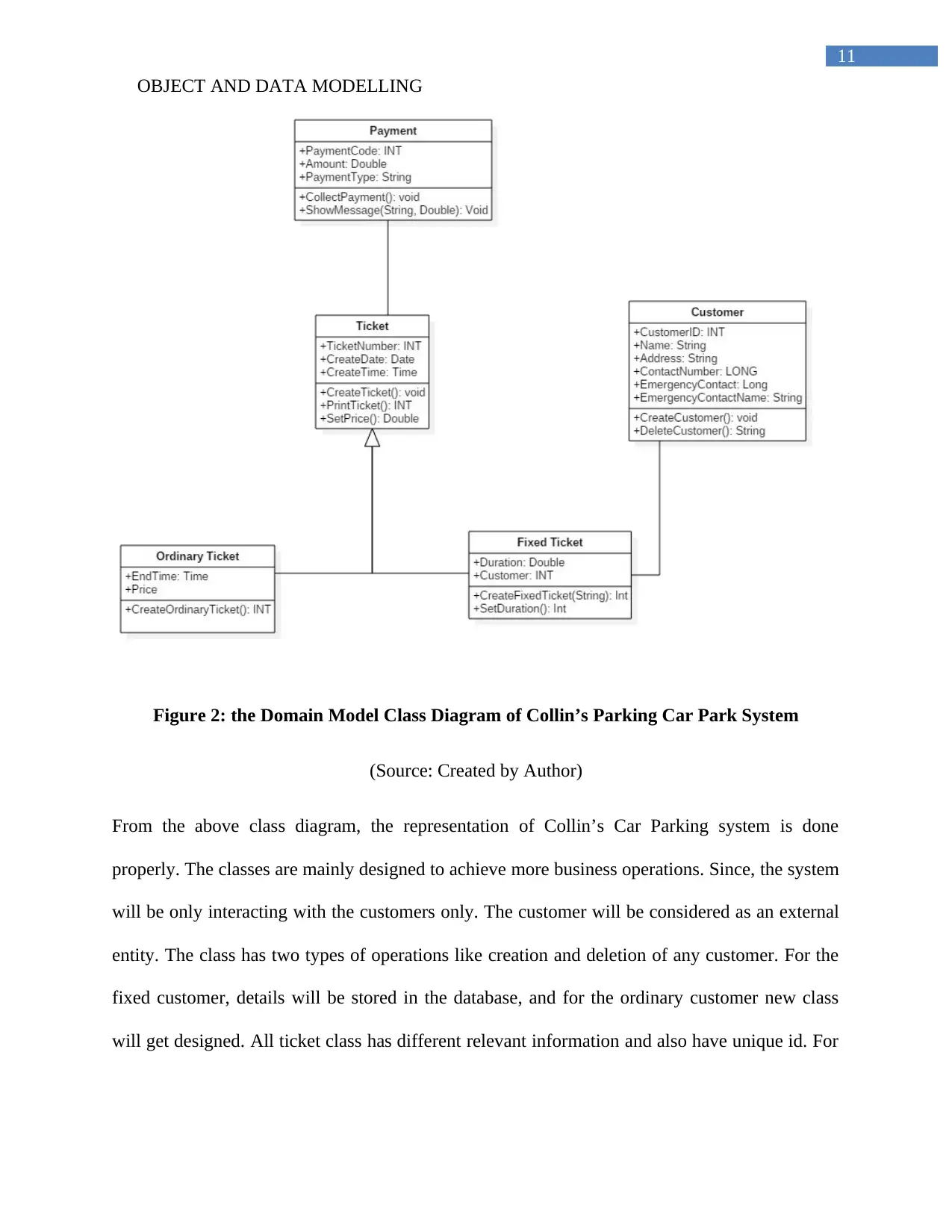
11
OBJECT AND DATA MODELLING
Figure 2: the Domain Model Class Diagram of Collin’s Parking Car Park System
(Source: Created by Author)
From the above class diagram, the representation of Collin’s Car Parking system is done
properly. The classes are mainly designed to achieve more business operations. Since, the system
will be only interacting with the customers only. The customer will be considered as an external
entity. The class has two types of operations like creation and deletion of any customer. For the
fixed customer, details will be stored in the database, and for the ordinary customer new class
will get designed. All ticket class has different relevant information and also have unique id. For
OBJECT AND DATA MODELLING
Figure 2: the Domain Model Class Diagram of Collin’s Parking Car Park System
(Source: Created by Author)
From the above class diagram, the representation of Collin’s Car Parking system is done
properly. The classes are mainly designed to achieve more business operations. Since, the system
will be only interacting with the customers only. The customer will be considered as an external
entity. The class has two types of operations like creation and deletion of any customer. For the
fixed customer, details will be stored in the database, and for the ordinary customer new class
will get designed. All ticket class has different relevant information and also have unique id. For
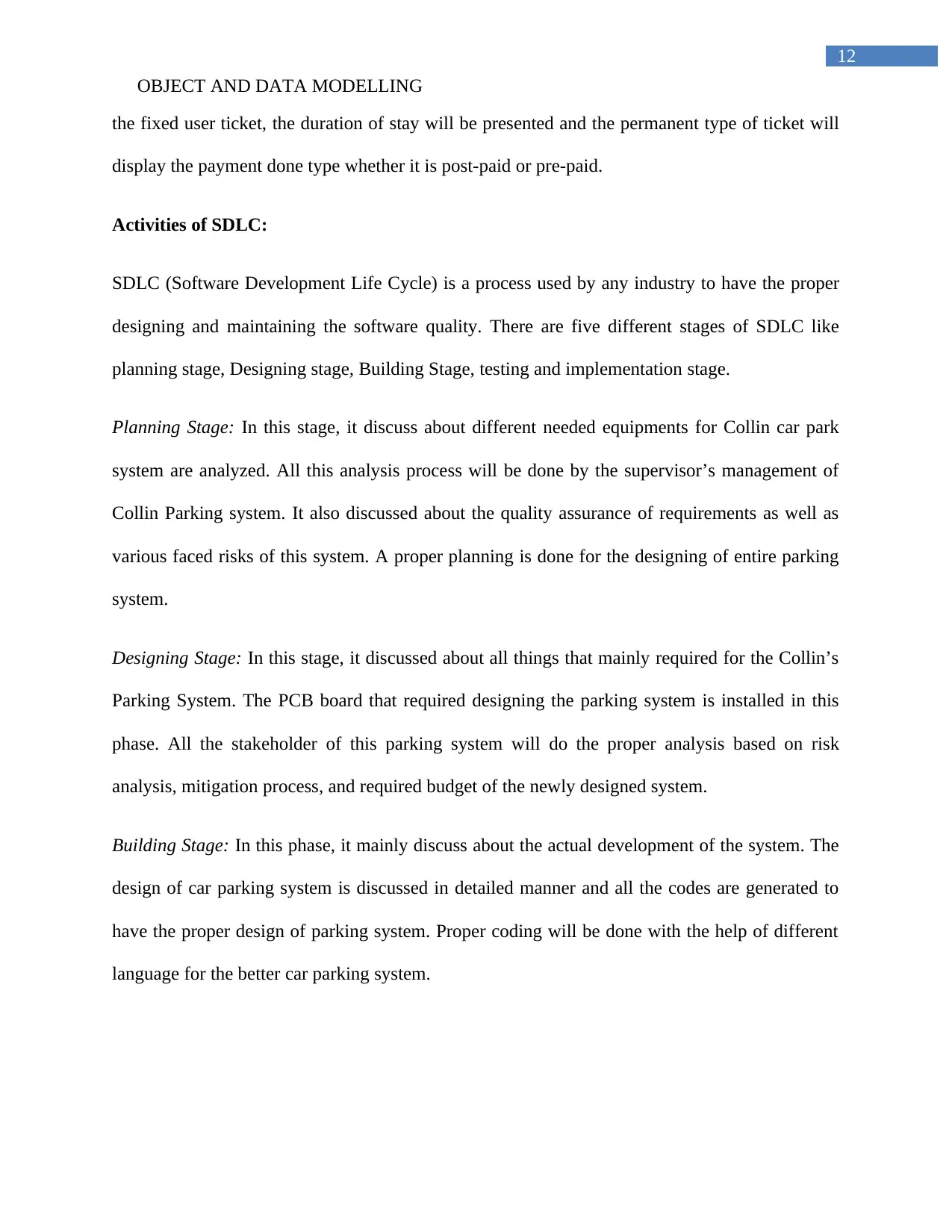
12
OBJECT AND DATA MODELLING
the fixed user ticket, the duration of stay will be presented and the permanent type of ticket will
display the payment done type whether it is post-paid or pre-paid.
Activities of SDLC:
SDLC (Software Development Life Cycle) is a process used by any industry to have the proper
designing and maintaining the software quality. There are five different stages of SDLC like
planning stage, Designing stage, Building Stage, testing and implementation stage.
Planning Stage: In this stage, it discuss about different needed equipments for Collin car park
system are analyzed. All this analysis process will be done by the supervisor’s management of
Collin Parking system. It also discussed about the quality assurance of requirements as well as
various faced risks of this system. A proper planning is done for the designing of entire parking
system.
Designing Stage: In this stage, it discussed about all things that mainly required for the Collin’s
Parking System. The PCB board that required designing the parking system is installed in this
phase. All the stakeholder of this parking system will do the proper analysis based on risk
analysis, mitigation process, and required budget of the newly designed system.
Building Stage: In this phase, it mainly discuss about the actual development of the system. The
design of car parking system is discussed in detailed manner and all the codes are generated to
have the proper design of parking system. Proper coding will be done with the help of different
language for the better car parking system.
OBJECT AND DATA MODELLING
the fixed user ticket, the duration of stay will be presented and the permanent type of ticket will
display the payment done type whether it is post-paid or pre-paid.
Activities of SDLC:
SDLC (Software Development Life Cycle) is a process used by any industry to have the proper
designing and maintaining the software quality. There are five different stages of SDLC like
planning stage, Designing stage, Building Stage, testing and implementation stage.
Planning Stage: In this stage, it discuss about different needed equipments for Collin car park
system are analyzed. All this analysis process will be done by the supervisor’s management of
Collin Parking system. It also discussed about the quality assurance of requirements as well as
various faced risks of this system. A proper planning is done for the designing of entire parking
system.
Designing Stage: In this stage, it discussed about all things that mainly required for the Collin’s
Parking System. The PCB board that required designing the parking system is installed in this
phase. All the stakeholder of this parking system will do the proper analysis based on risk
analysis, mitigation process, and required budget of the newly designed system.
Building Stage: In this phase, it mainly discuss about the actual development of the system. The
design of car parking system is discussed in detailed manner and all the codes are generated to
have the proper design of parking system. Proper coding will be done with the help of different
language for the better car parking system.
⊘ This is a preview!⊘
Do you want full access?
Subscribe today to unlock all pages.

Trusted by 1+ million students worldwide
1 out of 15
Related Documents
Your All-in-One AI-Powered Toolkit for Academic Success.
+13062052269
info@desklib.com
Available 24*7 on WhatsApp / Email
![[object Object]](/_next/static/media/star-bottom.7253800d.svg)
Unlock your academic potential
Copyright © 2020–2025 A2Z Services. All Rights Reserved. Developed and managed by ZUCOL.





